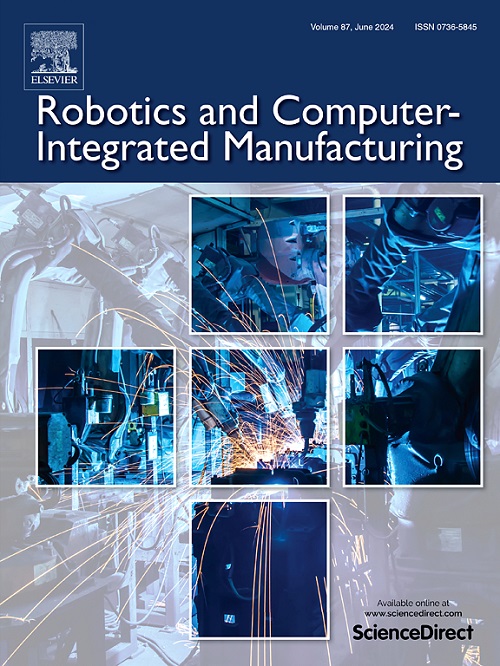Batch EOL products human-robot collaborative remanufacturing process planning and scheduling for industry 5.0
IF 11.4
1区 计算机科学
Q1 COMPUTER SCIENCE, INTERDISCIPLINARY APPLICATIONS
引用次数: 0
Abstract
With the advancement of technology, the growing volume of end-of-life (EOL) products in manufacturing poses significant challenges to achieving sustainability and green transformation. Proper treatment of EOL components is a critical step toward green and sustainable manufacturing development. Remanufacturing, capable of transforming EOL products into items with performance comparable to or surpassing new products, has become a vital method for achieving sustainable manufacturing. Recently, Industry 5.0 has introduced a "human-centric" philosophy, elevating workers from passive participants to indispensable elements in enterprises. As a critical bridge between EOL products and remanufactured goods, integrating this human-centric philosophy into remanufacturing processing planning is of profound significance. Human-robot collaborative processing modes serve as a key means to realize this philosophy; However, research on human-robot collaborative strategies in remanufacturing processing remains underexplored. To address this gap, this study proposes a batch-oriented EOL human-robot collaborative remanufacturing process planning and job-shop scheduling (BHRCRPS) model based on two-layer coding theory. The upper-level model selects human-robot collaboration modes aligned with the human-centric philosophy by minimizing worker fatigue and maximizing robot task completion. The lower-level model, constrained by the upper-level results, establishes a multi-objective model incorporating time, cost, and energy consumption for remanufacturing process planning and shop floor scheduling, aiming to enhance efficiency, profitability, and energy savings. To efficiently solve the BHRCRPS model, a hybrid algorithm integrating the Grey Wolf Optimizer (GWO) and Rat Swarm Optimizer (RSO) is developed. Finally, the applicability of the model is validated through a case study on worn worm gear remanufacturing, and the superiority of the proposed GWO-RSO algorithm is demonstrated by comparisons with state-of-the-art algorithms.
面向工业5.0的批量EOL产品人机协同再制造工艺规划与调度
随着技术的进步,制造业中报废产品(EOL)的数量不断增加,对实现可持续发展和绿色转型提出了重大挑战。正确处理EOL组件是实现绿色和可持续制造业发展的关键一步。再制造能够将EOL产品转化为与新产品性能相当或超过新产品的产品,已成为实现可持续制造的重要方法。最近,工业5.0引入了“以人为本”的理念,将工人从被动的参与者提升为企业不可或缺的要素。作为EOL产品与再制造品之间的重要桥梁,将这种以人为本的理念融入再制造加工规划中具有深远的意义。人机协同处理模式是实现这一理念的关键手段;然而,再制造过程中人机协同策略的研究还不够深入。针对这一缺陷,本研究提出了一种基于双层编码理论的面向批量的EOL人机协同再制造工艺规划与作业车间调度(BHRCRPS)模型。上层模型从最小化工人疲劳和最大化机器人任务完成度的角度出发,选择符合以人为本理念的人机协作模式。低层模型在上层结果的约束下,为再制造工艺规划和车间调度建立了一个包含时间、成本和能耗的多目标模型,以提高效率、盈利能力和节能。为了高效求解BHRCRPS模型,提出了一种将灰狼优化器(GWO)与鼠群优化器(RSO)相结合的混合算法。最后,通过对磨损蜗轮再制造的实例研究,验证了该模型的适用性,并通过与现有算法的比较,验证了所提GWO-RSO算法的优越性。
本文章由计算机程序翻译,如有差异,请以英文原文为准。
求助全文
约1分钟内获得全文
求助全文
来源期刊
CiteScore
24.10
自引率
13.50%
发文量
160
审稿时长
50 days
期刊介绍:
The journal, Robotics and Computer-Integrated Manufacturing, focuses on sharing research applications that contribute to the development of new or enhanced robotics, manufacturing technologies, and innovative manufacturing strategies that are relevant to industry. Papers that combine theory and experimental validation are preferred, while review papers on current robotics and manufacturing issues are also considered. However, papers on traditional machining processes, modeling and simulation, supply chain management, and resource optimization are generally not within the scope of the journal, as there are more appropriate journals for these topics. Similarly, papers that are overly theoretical or mathematical will be directed to other suitable journals. The journal welcomes original papers in areas such as industrial robotics, human-robot collaboration in manufacturing, cloud-based manufacturing, cyber-physical production systems, big data analytics in manufacturing, smart mechatronics, machine learning, adaptive and sustainable manufacturing, and other fields involving unique manufacturing technologies.

 求助内容:
求助内容: 应助结果提醒方式:
应助结果提醒方式:


